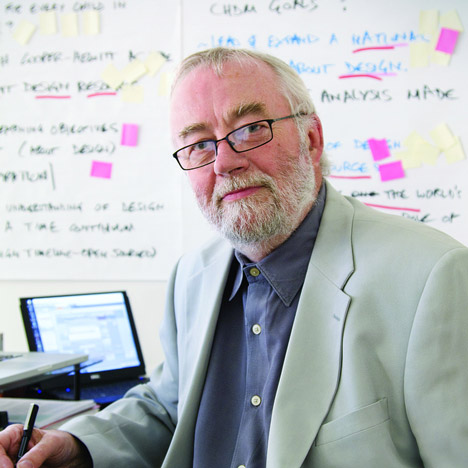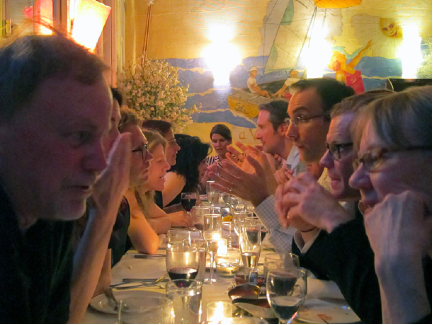 With all the incredible people we've met in the design world, especially in our own community in New York City, there were very few that matched the intellect, drive, and downright pleasantness of Bill Moggridge. We were lucky enough to have him in the fold at many design events in New York, not to mention our great chats with him at so many symposiums and IDSA conferences, where we were so impressed by a man who added so much to the design world and really had an impact on human culture that far too many do not know.
He is perhaps best known as the father of the laptop computer, the key mind in creating its design and ergonomic standards, and the man who created the basis for a tool that millions cannot live without today. He was a pioneer of what would become interaction design, and was a key architect in the forming and naming of the discipline. He went on to form one of if not the most influential design firms ever created, IDEO, which has continued to create new and incredible products and experiences.
He left us while heading the Cooper-Hewitt, busy putting the final touches on a great fundraising campaign that will grow the design museum by 60%, and create a new National Design Library in New York.
But the thing we'll miss most is our wonderful discussions with the man, so intelligent and down-to-earth, who lived and breathed design. You will be missed.
With all the incredible people we've met in the design world, especially in our own community in New York City, there were very few that matched the intellect, drive, and downright pleasantness of Bill Moggridge. We were lucky enough to have him in the fold at many design events in New York, not to mention our great chats with him at so many symposiums and IDSA conferences, where we were so impressed by a man who added so much to the design world and really had an impact on human culture that far too many do not know.
He is perhaps best known as the father of the laptop computer, the key mind in creating its design and ergonomic standards, and the man who created the basis for a tool that millions cannot live without today. He was a pioneer of what would become interaction design, and was a key architect in the forming and naming of the discipline. He went on to form one of if not the most influential design firms ever created, IDEO, which has continued to create new and incredible products and experiences.
He left us while heading the Cooper-Hewitt, busy putting the final touches on a great fundraising campaign that will grow the design museum by 60%, and create a new National Design Library in New York.
But the thing we'll miss most is our wonderful discussions with the man, so intelligent and down-to-earth, who lived and breathed design. You will be missed.
DesignBoost’s “Design Beyond Design” Event at Cooper Hewitt: Part Two
Our second day at Designboost was comprised of lectures by leaders pushing the boundaries of the design world. Of all of the lectures I was able to attend, I enjoyed the playful energy Philip Tiongson’s company Potion has been bringing to the interaction design & technology space.

My absolute favorite was Aaron Dignan’s lecture entitled “The Future of Work is Play.” He talks about the formula for creativity and play and how business has to understand the fine line and balance between boredom to creativity to anxiety. It’s exciting to hear because this is one of the main aspects that Yeh IDeology analyses when we match talent with our client’s opportunities. We look for that fine balance of variety and challenge so that the right candidate will be as ideally enthralled by the opportunity and the company energized by a committed new member with initiatives that are aligned to their creative team’s mission.
See Aaron's lecture below:
See part one of our coverage of the Designboost event here!
DesignBoost’s “Design Beyond Design” Event at Cooper Hewitt: Part One
I had a delightful time at the first Designboost held in the US hosted by the Cooper-Hewitt Design Museum last week. It was an honor to be surrounded by such design luminaries.
 image (via)
image (via)
On the first day, I participated in a discussion where the first statement was: “When design has turned global, production is still local.” We debated about the different aspects and ramifications of design and globalization. How do you balance the standardization that comes with globalization and how do you bring local globally? Together with Avani Agarwal, Fredrik Andersson, Carla Diana, Davin Stowell, Barry Richards, Chris Streng, and Karen John in my group we shared our own varying experiences with globalization of design. We came out with so many varying concepts that were diverse in their objectives and solutions.
I hypothesized if you devised a design service template that could overlay any industry culture then the local cultural resources whether it be people, ideas or materials could grow and fill in that lattice. Then structurally each design service template would resemble the others and yet each locale’s end result would be unique from the local origins of it’s ingredients. Somewhat like how Mc Donald’s sells pasta in Italy and sushi in Japan each caters to it’s own local preferences and yet there’s continuity to the brand.
The second event I attended was entitled “Where does politics end and design begin?” In this seminar, together with Ivar Draganja, Avani Agarwal, Carla Diana, Andrea Ruggiero, Julie Taraska, and Brad Dixon, we discussed the various ways in which design and politics impact each other, and if they even should work together. “Can the two form a strong unit, and make a real difference and should they?
I ultimately believe that design could really help our government, especially now when we are seeking to reevaluate the ways in which our government work. Design in the form of design research, design strategy, and service design could play a huge part in helping to explore where to go from here. Think of the research that could be done on the healthcare and education system. This one was a fascinating topic and I was chosen to be video taped for this one. Stay tuned for the clip once it’s posted. I hope I sound articulate.
For each seminar, Designboost chose one representative to speak about the topic at hand. I was lucky enough to be chosen for one of them, and the video should make it onto the Internet sometime soon—I will share it with you then.
 image (via)
image (via)
That night we all had fun at a speed networking event. Exhausting yet fun and fueled with wine & Swedish whiskey I met so many people passionate with their own unique design initiatives. There was so much networking going on you could barely hear yourself over the cacophony and energy of sharing initiatives & support.
See part two of our coverage of the Designboost event here!
